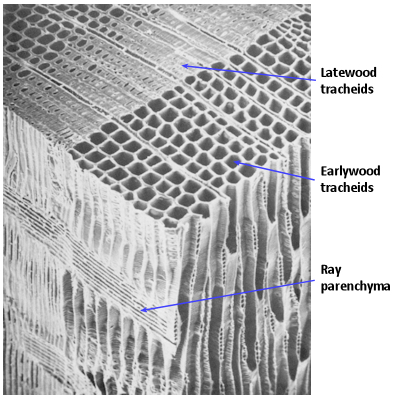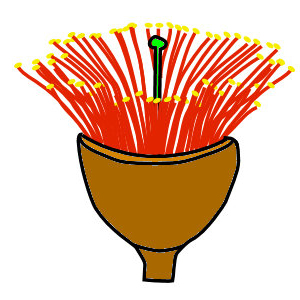Softwoods and hardwoods
When trees are processed and used for timber, the wood that’s produced is commonly referred to as either a softwood or hardwood. Although it’s true that most hardwoods are harder than most softwoods in terms of the effort required to cut or work with the timber, it’s not universally the case. The fundamental difference between hardwoods and softwoods is in their cell structure.
Softwoods

Botanically speaking, softwoods are gymnosperms, which means ‘naked seeds’. This is a reference to the fact that the seeds are exposed when the scales on a softwood cone open up.
The image at right shows the cell structure of the xylem tissue in a typical softwood species – in this case, Douglas fir. This magnified photo was taken through a microscope by the CSIRO (photo used with permission).
You can see that the latewood tracheids have thick cell walls and small cell cavities. To the naked eye, they appear as a dark growth ring that forms during ‘summer growth’.
By contrast, the earlywood tracheids have thinner cell walls and much larger cavities, corresponding to the wide band of ‘spring growth’ that appears in between the latewood growth rings.
Tracheids perform two functions – they transport liquids from the roots to the leaves, and also provide structural support to the tree. Depending on the species of tree, the tracheids may be from about 3 mm long to 10 mm long individually.
The water travels through the cell cavities, and moves from one tracheid to the next through bordered pits in the cell walls. The pits provide gaps or holes in the secondary wall of the cell, allowing liquid to pass through the porous primary wall membrane.
The ray parenchyma (or medullary rays) are used to transport and store food supplies. They radiate from the centre of the tree towards the bark. Food that isn’t needed immediately for growing is stored in the ray cells in the form of starch.
Hardwoods

Hardwood trees have a different cell structure in the xylem tissue. In botanical terms they are called angiosperms, which literally means ‘covered seeds’, because the seeds are contained in gum nuts or flowers.
The photo at right shows the xylem tissue of a typical angiosperm tree, viewed through a microscope (used with permission from the CSIRO).
Liquids are transported through the vessels (also called ‘pores’), which are arranged vertically to form columns. The ends of the cells are either pitted or completely open, allowing water to move through. Small pits also occur on the side walls to connect the cells with adjacent vessels or ray cells.
Structural support is provided by the fibres, which make up the bulk of the wood. They have very heavy cell walls and cavities that are generally too small to allow the movement of liquids.
The ray parenchyma perform a similar function to the ray cells in softwoods.
Reproduction in gymnosperms and angiosperms

Gymnosperms are more ancient in origin than angiosperms. There are only about 1000 species of gymnosperms in total. Most of these are conifers, but the classification also includes cycads, gnetophytes and the ginkgo tree. They all produce woody tissue in their stem structure and tend to have needle shaped or scale-like leaves.
All conifers bear their seeds in cones. When the scales of the cone open up or disintegrate, the seeds are exposed to the environment and are able to be dispersed by the wind, or carried away by birds and animals.
The diagram at left shows a typical female pine cone. Pine trees have both male and female cones on the same tree. The male cone produces pollen, and the female cone contains the ovules, or eggs. When the eggs are fertilised by the pollen, they become seeds.
Angiosperms, by contrast, bear their seeds in fruits, and have flowers as part of their reproductive organs. The petals on the flower are designed to attract pollinators, such as birds, bees, bats and butterflies.

Some angiosperm trees, such as Magnolias, Jacarandas and Acacias have showy flowers that make them popular as ornamental trees. Other trees, including many Eucalyptus species, tend to have much more understated flowers, and in most species the flower bud incorporates the petals into the cap, which gives the appearance that there are no petals at all.
Angiosperms have evolved to comprise over 300,000 species, representing about 80% of all known green plants. They have managed to adapt to virtually every climate and geographical region around the world, and include trees, shrubs, herbs, vines and garden plants.
Commercial timber species
Below are some examples of commercial timbers that are commonly used in building work, furniture making and wood turning.
They are sorted into softwood and hardwood categories based on their cell structure – that is, whether they are ‘pored’ (hardwoods) or ‘non-pored’ (softwoods).

If you have used any of these timbers yourself in building or woodwork projects, you’ll know how hard or soft they feel relative to other species, and how the structure of their fibres tends to respond differently when cut, planed or sanded.
Some of the angiosperms obviously fit into the ‘hardwood’ category – such as ironbark and tallowwood, which are among the hardest timbers in the world. And some of the gymnosperms obviously fit into the ‘softwood’ category – such as radiata pine and western red cedar, which are both soft and easy to work with.
But there may be other species that might surprise you, such as balsa wood, which is extremely soft and lightweight, and yet botanically speaking is a hardwood. By contrast, cypress pine is a softwood – because the cell structure is ‘non-pored’ – and yet it does an excellent job as a hard-wearing and durable flooring product.
| Examples of softwoods (gymnosperms) | Examples of hardwoods (angiosperms) |
| Baltic pine (also called Scots pine) (Pinus sylvestris) |
Alpine ash (Eucalyptus delegatensis) |
| Douglas fir (also called oregon) (Pseudotsuga menziesii) |
Australian red cedar (Toona ciliata) |
| Hoop pine (Araucaria cunninghamii) | Balsa wood (Ochroma pyramidale) |
| Kauri pine (Agathis robusta) | Beech (Nothofagus cunninghamii) |
| Radiata pine (Pinus radiata) | Jarrah (Eucalyptus marginata) |
| Western red cedar (Thuja plicata) | Light red meranti (Shorea argenifolia) |
| Western hemlock (also called Canada pine) (Tsuga heterophylla) |
Red ironbark (Eucalyptus sideroxylon) |
| White cypress pine (Callitris glaucophylla) | Rosewood (Pterocarpus indicus) |
| Spotted gum (Corymbia maculata) | |
| Tallowwood (Eucalyptus microcorys) |